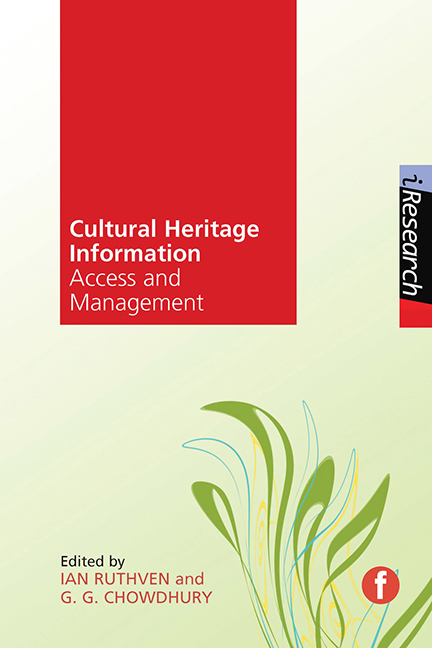Book contents
- Frontmatter
- Contents
- List of figures and tables
- Contributors
- Preface
- 1 Managing digital cultural heritage information
- 2 Digital humanities and digital cultural heritage (alt-history and future directions)
- 3 Management of cultural heritage information: policies and practices
- 4 Cultural heritage information: artefacts and digitization technologies
- 5 Metadata in cultural contexts – from manga to digital archives in a linked open data environment
- 6 Managing cultural heritage: information systems architecture
- 7 Cultural heritage information: users and usability
- 8 A framework for classifying and comparing interactions in culturalheritage information systems
- 9 Semantic access and exploration in cultural heritage digital libraries
- 10 Supporting exploration and use of digital cultural heritage materials: the PATHS perspective
- 11 Cultural heritage information services: sustainability issues
- Index
Preface
Published online by Cambridge University Press: 10 September 2022
- Frontmatter
- Contents
- List of figures and tables
- Contributors
- Preface
- 1 Managing digital cultural heritage information
- 2 Digital humanities and digital cultural heritage (alt-history and future directions)
- 3 Management of cultural heritage information: policies and practices
- 4 Cultural heritage information: artefacts and digitization technologies
- 5 Metadata in cultural contexts – from manga to digital archives in a linked open data environment
- 6 Managing cultural heritage: information systems architecture
- 7 Cultural heritage information: users and usability
- 8 A framework for classifying and comparing interactions in culturalheritage information systems
- 9 Semantic access and exploration in cultural heritage digital libraries
- 10 Supporting exploration and use of digital cultural heritage materials: the PATHS perspective
- 11 Cultural heritage information services: sustainability issues
- Index
Summary
Memory institutions have long been engaged in managing cultural heritage information resources. However, access to, and use of, such resources have been limited, and in many cases restricted, because of the nature and quality of the resources themselves and the associated conservation issues. This scenario has changed over the past two decades due the advent and proliferation of internet technologies which have opened up new opportunities for the creation of digital copies of cultural heritage information resources that could be accessed from anywhere in the world without causing any physical damage to the resources resulting from everyday usage. Massive digitization of cultural heritage information resources over the past few years has given rise to a number of digital cultural heritage information services created at the national level, such as the American Memory in the USA (memory.loc.gov), and at the international level, such as the Europeana Digital Library (www. europeana.eu). It also facilitated better access to cultural heritage information due to the adoption of advanced interactive information retrieval techniques by cultural heritage digital libraries.
While the internet and the processes of digitization, indexing and retrieval activities offered new opportunities for providing better and wider access to cultural heritage information, they also posed several new challenges. Some of these challenges are associated with the resources, tools and technologies used for digitization, while others are related to access and use. Cultural heritage information resources can range from manuscripts to text and images, audio and video, and are often a combination of many of these forms; these multiple forms can pose specific challenges for metadata and indexing that are the key to providing access to digitized resources. Users of cultural heritage information can also have specific characteristics that need to be considered in order to design the most effective digital information systems that will facilitate interactive and contextual access to information. Since digitization of cultural heritage information is quite resource-intensive, such activities need to be governed by policies and guidelines. Some heritage information resources may be sensitive to specific communities and cultures, and similarly some cultural heritage resources may have commercial potential. Access to such resources therefore needs to be governed by appropriate policies and practices, and a number of policies and guidelines are also associated with the creation, access and management of cultural heritage information resources.
- Type
- Chapter
- Information
- Cultural Heritage InformationAccess and Management, pp. xv - xviiiPublisher: FacetPrint publication year: 2015
- 1
- Cited by



